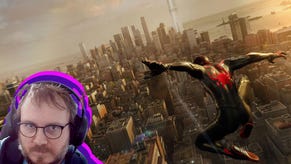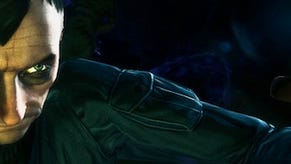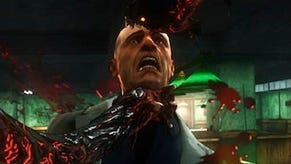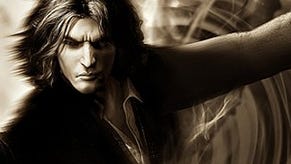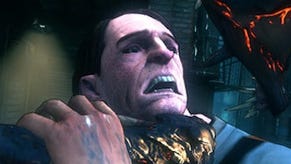Worshipping The Darkness II: "Let's not f**k it up"
The buzz around The Darkness II has grown to a roar. We braved the noise to ask producer Seth Olshfski about story-driven gaming, immersion and 'not f**king it up'.
"You know how people make their top ten lists of emotional moments or good stories in games? The Darkness I is almost always on it. People are fanatical about it because the story was so compelling, so it's really hard to do a follow-up to that. It's like, 'Wow, people worship this game - let's not f**k it up.'"
"You know how people make their top ten lists of emotional moments or good stories in games? The Darkness I is almost always on it. The story was phenomenal. People are fanatical about it because the story was so compelling, so it's really hard to do a follow-up to that. It's like, 'Wow, people worship this game - let's not f**k it up,'" The Darkness II producer Seth Olshfski told VG247.
"That's a lot of the way we looked at it - being really respectful of how awesome the first game was. So pre-production took a while. We were like, 'What story do we tell now?' In order to stay respectful to the quality of the story - Paul Jenkins wrote a bunch of the comics; he wrote the first game - we brought him in to write the second game. He's up to his same sorts of tricks."
One of these tricks occurs early in the game, and is included in the demo - if you want to remain spoiler free, skip the next two paragraphs.
"You played the beginning of the consumer demo and you saw walking in behind Vinny along the restaurant, and you're sitting there with twins and then…" Olshfski gestured to indicate the startling death. "He wrote into it exactly where in her sentence she would get shot to make it the most jarring."
"Tricks" like this occur throughout the game's story and put The Darkness II in a different realm to many run-and-gun shooters.
"If you haven't seen it before you totally don't expect it and [from then on] you're always on your toes. It's so easy to write for the lowest common denominator, where it's a really bland save-the-princess story, and those are not interesting. We tried to really push it to really risky decisions," the producer remembered.
Despite Jenkins' guiding hand, some of the sequences in The Darkness II don't play like they were written by a comics writer; they play as if they were crafted by a game designer. A good example is the short tutorial following the events discussed above - the player is introduced to the controls individually, beginning with one hand before introducing dual wield; movement; and finally, quad wield - all within a story which lends sense to these arbitrary restrictions.
"That was totally collaborative. He's a very good game writer. His brain works well for understanding how you tell a story in games," Olshfski said.
"It was a core pillar of our development that everything we did was in the service of story. And at the same time he knows that we make video games. In a movie you tell story by showing things and by having people talk. When you do that in a game you're not playing the game any more you're watching a movie. That's just not the same thing. You have to tell the story in games by doing.
"Here with the twins, you're walking behind the guy and you get what's going on. You're not taken out of the environment. And then you're part of the hit - someone shot her right in front of you and you're like, 'F**k you, dude! They seemed fine! What's wrong with this?' You really start feeling inspired for revenge because you, as a player, since you embody the person who's in that world, you're doing it. And that's when you start to actually have a reaction to what's happening there, because he's an extension of you. That's part of why we're so strict about first-person. A lot of people would have shown a video of you - of Jackie - and then twins, sitting at a table. We never take you out of Jackie's eyes."
The game does do that, in fact, but only in later stages thanks to the Darkling character, giving Digital Extremes a chance to show off Jackie's rarely-glimpsed but awesome character model.
"So [Jackie's character model] is there, it's done, and it's cool - but it's just not how we wanted to tell the story. We wanted to tell the story of: you are Jackie, and you are experiencing these things as Jackie. So it had to be first-person all the way through," Olshfski said.
"It was really hard to figure out how to do that. How do you show that you are Jackie, and you just got blown up? Normally you'd just show the explosion, and the person in the explosion, and you're done. But when you're in the explosion, how do you tell that story?
"It was really difficult, but I think it really paid off because you really become connected to the story. A lot of that is Paul."
Returning to the introductory sequence as an example of supporting player connection to a narrative. Olshfski said 2K, Digital extremes and Jenkins all agreed on the need for a plot-driven tutorial.
"You can always be like, 'Let's warp to this other world and view a tutorial' - but that felt lame. So we wanted to ease you into every bit of quad-wielding because having four weapons at your disposal is really complicated, and we didn't want to make it feel complicated," he explained.
"Hopefully by the time you reach the streets, which is not very far into the game, you get what the four quad-wielding buttons do - guns on the triggers, demon arms on the shoulders. We wanted to make it feel like you were awesomely powerful but that it wasn't hard to get it."
It really isn't hard to get at all. The quad-wield controls are physically analogous to Jackie's limbs, an observation Olshfski was happy to pounce on.
"We put [them] there because that maps to the brain really easily; where it is on the screen is where it is on the controller."
Making Jackie feel like a comfortable avatar was a major focus for Digital Extremes, and one reason he's so human.
"If you do the narrative right, then when you're playing you're always going, 'What if I did this?' and then that's what happens. We've set things up so that you're always trying to guess one step ahead and you're almost always right," Olshfski said.
"[Jackie] as a character is a great vessel to put every player into. It's hard to figure out narrative stuff at the same time you're figuring out gameplay stuff. We try to meter it out over the game so that you're never confused about what's going on, but you're also never being preached to. Having Jackie be just smart enough was a good way to make that work. And in the comics, he's also just smart enough; he's not the superhero, super-brain guy."
In some ways, Jackie's character is the polar opposite of a superhero's. Batman, for example, doesn't have any special powers, but the way he conducts his life is beyond belief despite that. Jackie's reactions to extraordinary events feel ordinary, the kind of reactions you or I might have upon having our lives invaded by supernatural forces.
"The Batman thing, or the awesomely intelligent thing, leads to places where you as the player go, 'S**t, I don't know how I would get out of this'. And then the character in the video game, who's supposed to be an extension of you, comes up with something on their own, and suddenly they're not you any more. Because you didn't think of that," the producer said.
"With Jackie, as you think of it he thinks of it too. You have to figure out the puzzles on your own. I think you're more invested in the narrative when there aren't like, 'Oh, there's a horrible plot point, I don't know how to get past it! Oh, did we forget, in this world in my back pocket I have a thing that lets me fly.' Things that there's no way that you as a player would know. [By contrast] we lay it all out there for you."
The Darkness II is out now on all HD platforms.




